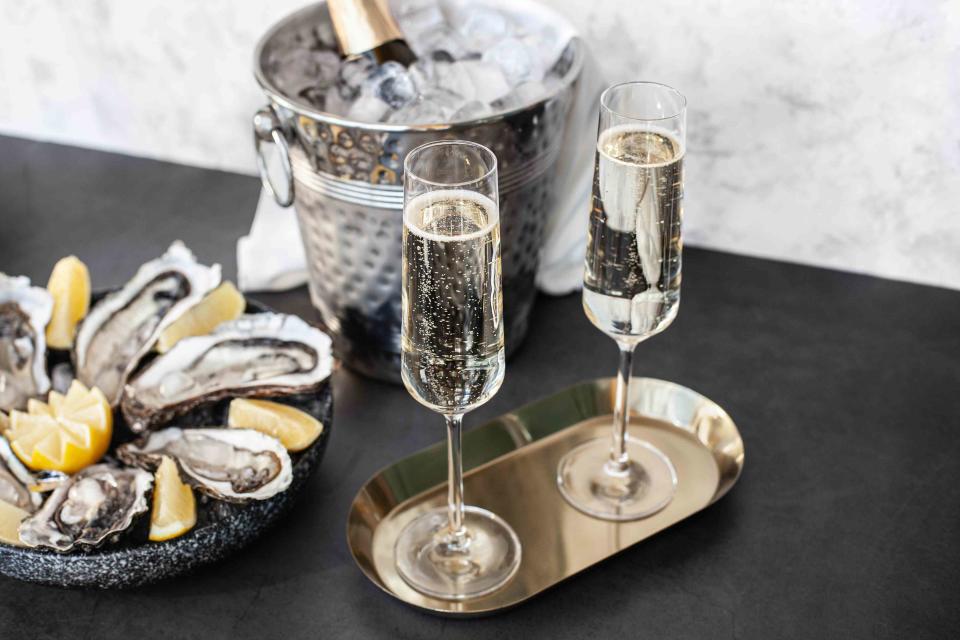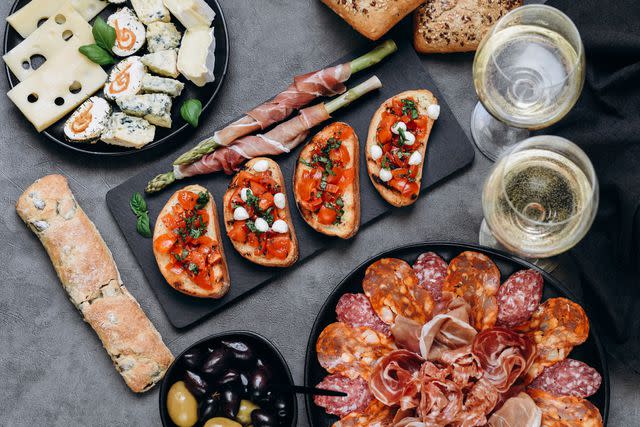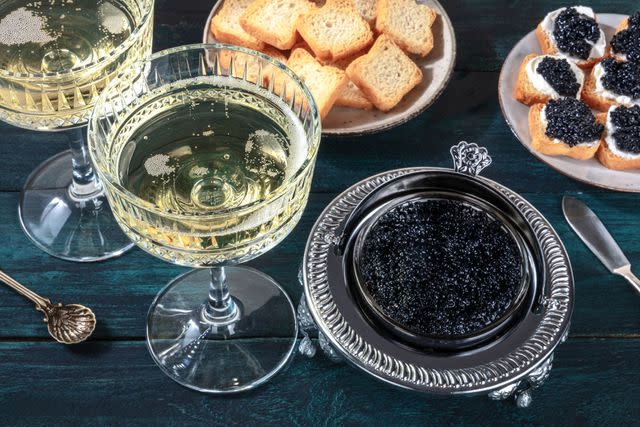A Case for Why Sparkling Wine Pairs with Everything
Versatile and food-friendly, pop the bubbly for any occasion.

Shvaygert Ekaterina / Shutterstock
Sparkling wine is far more versatile and food-friendly than conventional pairing wisdom lets on. Have you ever had a blanc de blanc Champagne with crispy fried chicken, washed down Italian mortadella with a frosty glass of Prosecco, or paired your New York slice with a sparkling ruby-hued Lambrusco?
Amanda McCrossin, a sommelier and host of the Wine Access Unfiltered podcast, is a keen advocate for popping corks when considering food pairings.
Related: A Case for Pairing White Wine With Beef
”Sparkling wine isn’t a one-size-fits-all category,” says McCrossin. “Like any other category of wine, sparkling wine is made all over the world and laden with choices that can work with various facets of our lives.” McCrossin will be hosting a session on pairing sparkling wines with everything at the Food & Wine Classic in Aspen this year, and pouring a variety of bubbles to help make her case.
Finding the perfect Prosecco pairing
McCrossin likens picking out a sparkling wine to planning out an outfit.
“You’ll quickly discover that Prosecco and Champagne, like pajamas and a cocktail dress, were destined for different things. Treat them accordingly,” she says. “You wouldn’t wear a cocktail dress to a football game or don pajamas to a work event.”
“[Prosecco] is the ultimate aperitivo wine — easy to drink and lovely to sip with food, especially the snacky kind,” continues McCrossin. “It isn’t built for long aging so it’s meant to be consumed in the moment. It isn’t meant to be taken seriously.”

Elena Katkova / Getty Images
McCrossin points to at the ancestral home of Prosecco, the Valdobbiadene region of Italy, and how the sparkling wine is enjoyed there. “Prosecco is consumed like water,” she says.
Pour Prosecco in carefree situations, alongside weekend lunches and seasonal salads, with snack dinners and grazing platters, or paired with Italian dishes like farinata or crispy gnocchi. Have a few glasses left in the bottle? Lend the leftovers to your pre-dinner aperitivo or post-dinner digestivo.
Champagne’s perfect match
“Champagne, on the other hand, is significantly more serious and requires a bit more care on the serving side,” says McCrossin.
Typically, she’ll pair Champagnes with dishes that flex more intricacy. “Champagne has more complex aromatics and palate, can be aged for longer, and can pair with a variety of foods, ranging from cheeses to intricate dishes like scallops and lobster,” she says.
Like the broader sparkling wine category, there’s diversity within Champagne and no one-size-fits-all approach.

Plateresca / Getty Images
Extra brut wines work well with the briney and the salty dishes: oysters, sushi, or something crispy and fried. The expressive minerality of a blanc de blanc is perfect with classic pairings like caviar or crispy fried chicken. Try an aged Champagne, one with notes of yeast, hazelnuts and crème brûlée, with slices of Comté cheese or even mac and cheese. McCrossin is also a fan of pairing brut rosé Champagne (specifically Laurent-Perrier’s) with rich and meaty dishes.
Priced out of Champagne? Cava and corpinnat, Spanish sparkling wines made in the same style of Champagne, often offer the same characteristics of Champagne at a more budget-friendly price point.
"“The acid of the wine needs to be as high or higher than the food it’s paired with. And since Champagne has the highest acidity of any wine made, it’s virtually impossible to find something it can’t party with.” — Amanda McCrossin, sommelier and host of the Wine Access Unfiltered podcast"
McCrossin has one golden rule when pairing sparkling wine with food. “The acid of the wine needs to be as high or higher than the food it’s paired with,” she says. “And since Champagne has the highest acidity of any wine made, it’s virtually impossible to find something it can’t party with.”
However, McCrossin does advise to not overthink it too much. “Pairings don’t have to be fancy,” she says. “I love Champagne with potato chips — high fat and salt content goes brilliantly with sparkling, and even just a handful of nuts.”
Exploring the world of sparkling wine
Beyond stalwarts like Champagne and Prosecco, excellent bubbles can be found around the world. In England, producers like Wiston, Chapel Down, and Hattingley Valley lean into the region’s signature chalky soil, similar to those found in Champagne. Pair these bottles with fish and chips or British cheeses.
In South Africa, producers leverage the traditional méthode cap classique process to make Champagne-like wines that showcase South African terroir. Open a bottle to cut the fat of fried food — croquettes, arancini, or Southern-fried mushrooms.
Lambrusco, a deep red frizzante produced in Italy is perfect for pizza or anything covered with tomato sauce.
Then there’s pétillant naturel, made using the ancestral method, meaning, it’s bottled during the first fermentation, and one of the oldest styles of sparkling wine. Pét-nats are made all over the world from any grape variety, so there’s no typicity — many are wild and slightly fizzy, but beyond that, they can be bready, savory, and golden orange. This style of wine can also be cloudy, acidic, and the color of sunshine, or rich and rosy. Pairings can range from roast chicken to tinned fish or spicy Thai dishes.
But the most fun way to find out what works best? Try everything you can.
For more Food & Wine news, make sure to sign up for our newsletter!
Read the original article on Food & Wine.

 Yahoo Lifestyle
Yahoo Lifestyle 
